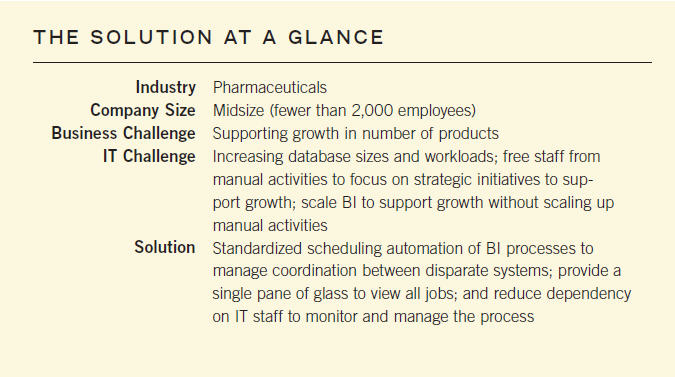CASE STUDY - Pharmaceutical Company Finds the Remedy to Boost Business Intelligence Process Performance: Automated End-to-End Scheduling Provides “Shot in the Arm” for Better ETL
By Thomas Hooker, Manager, Product Marketing, Cisco

Business Challenge
With business growth, IT is challenged to support dramatic increases in data processing. New and expanded product lines create more databases; increases in sales generate more data to process; and more transactions require increased individual intervention. In addition to workload increases, new strategic business initiatives need to be addressed by IT staff, and this requires freeing up valuable staff time. Doing this while successfully managing a larger workload involves sophisticated and intelligent automation in the data center.
A midsize, U.S.-based pharmaceutical company provides a good example. It sells a wide variety of both branded and specialty generic products, and the business is expanding. The company needed to increase its financial data warehousing to monitor direct sales and financial performance, and to closely monitor customer performance against contracts. Weekly reports are sent to a field organization of more than 800 representatives.
The key challenge was to ensure that IT could support the data center requirements for a growing business with a rising number of products. The company had to free staff resources to address the many new activities and processes necessary to support sustained growth.
Barriers to Success
IT depended too heavily on manually executing BI processes to support planned growth rates. Staff spent too much time manually conducting data loading, acquisition, and processing. These activities were not the ideal use of the staff’s time, so the business had to eliminate this intensive manual intervention. Success depended on standardizing a scheduling automation solution that coordinated all processes from a single point of control.
Although some automated scheduling was in place, it was not freeing up staff time. The scheduling automation was a hodgepodge of application-specific schedulers, as well as a number of application-specific analytic applications. There was no interaction, however, so these disparate schedulers were riddled with production problems that required constant staff intervention.
Scheduled jobs were time dependent, and downstream schedulers were unaware of upstream problems. Also, different applications would not work together in a single job stream. IT staff members were always busy doing things manually, or individually monitoring other activities, and could not take on additional tasks. A standardized scheduling solution with a single view and single point of control over all the running processes would dramatically alleviate this problem.
Automating the Process
Central automation was the key to organizing and controlling these disparate processes in one coherent system. Not only would it provide automated solutions to many of the problems that required staff intervention, but it could also significantly shorten the time it took many of the processes to run. A centralized automation solution would eliminate all the “wait states,” allowing processing of more event-driven activities and delivering vital information faster. When problems did arise, time to resolution was dramatically reduced, keeping critical processes on track.
The business quickly became comfortable with Tidal Enterprise Scheduler from Cisco. Referenced users told the company that although support was exceptional, the solution’s ease of use was so strong that they seldom needed support.
Business Results
The company predicts it will soon shave 20 percent off the time it takes to run jobs that include multiple jumps. It expects to free up six to eight hours of performing manual activities. However, the main benefit is enhanced visibility into operational stability as more processes are built into the system. Ultimately, by standardizing on an enterprise scheduling solution that covers a broad range of systems, applications, and other technology categories, it will save the pharmaceutical company time and help it shift resources to more strategic endeavors.
For a free white paper on this topic from Cisco, click here and choose the title “BI and ETL Process Management Pain Points: A Look at the Most Pressing Pain Points, and Strategies for Addressing Them.” For more free white papers, click here.